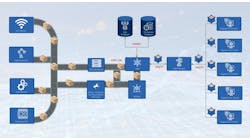The entire industrial community was especially hard hit by the COVID-19 pandemic and a suddenly remote workforce. Edge computing can help manufacturing and other industrial companies to overcome these challenges and position themselves for long-term success in the new normal and beyond.
Disrupted supply chains. A newly remote workforce. Reduced demand. Taken individually, any one of these factors is a challenge to a manufacturer, but in the post-COVID-19 era, most of them are now facing all of these issues, if not more, all at once.
Industrial companies, especially manufacturing and energy, may feel these pains much more acutely than those in any other industry. Nearly 80% of industrial manufacturers said they expect the COVID-19 crisis to have a significant impact on their businesses, according to “Economic and Operational Impacts of COVID-19 to Manufacturers,” a survey from the National Association of Manufacturers (NAM). This is much higher than the 48% of respondents from a mix of other industries reported in the PwC US CFO Pulse Survey.
It’s clear that COVID-19 will affect industrial companies well into 2021. What is not clear, however, is what the “new normal” will look like and what approaches these companies can take to overcome these complex challenges and best position themselves for long-term success.
Edge computing, which is a distributed computing architecture that collects and processes data at the furthest point, or “edge,” of a computer network is now a critical foundation for modern industrial operations. Edge computing helps to minimize infrastructure downtime that can lead to lower yields, regulatory fines and lost revenue, and provides the continuous availability and visibility companies need to maximize productivity and quality.
New normal
As an architecture design that brings computing and data storage closer to where they’re actually needed, edge computing is a proven way to reduce latency, increase bandwidth and improve overall response times. Yet edge computing is also the perfect complement to virtually any digital transformation strategy since it provides mission-critical data needed for the Industrial Internet of Things (IIoT), data analytics, predictive maintenance and so many other digital use cases.
Edge computing addresses current market challenges, considering it was purpose-built to ensure ongoing business operations in remote locations with minimal hands-on management. For example, edge-based solutions can enable remote monitoring, systems controls and asset management, all with little to no help from IT.
These capabilities provide an important advantage, especially during the COVID-19 pandemic. In most industrial and manufacturing companies, operations-technology (OT) staff are responsible for managing, maintaining and even troubleshooting important systems. Yet with so many employees now working from home, many OT employees are simply not on site. This puts even more emphasis on system uptime, redundant architectures and even intelligent, self-repairing technology. This is where edge computing excels.
IT approach to OT assets
Yet edge computing can help to close the OT-IT gap in another important way. OT staff members are very aware of the fact that IT can easily manage the vast majority of the company’s entire technology stack remotely. In the past, IT systems required daily, hands-on attention, but the recent popularity of cloud-based applications, workloads and even enterprise-level solutions means 24/7 access from home, the road or wherever the IT employee chooses to be.
Ideally, this same approach should work for OT, as well. In other words, as industrial companies grapple with post-COVID-19 issues, what can they do to implement a similar model for OT-owned assets and infrastructure?
Edge computing is a critical part of the answer. There’s a lot of software and security also needed with edge computing to meet the goal.
Edge-based technologies can collect and provide valuable data to improve visibility, make better decisions and optimize equipment performance. For example, manufacturers can use predictive analytics to plan the ideal time to change parts on a machine, maximizing production. Or energy producers can use IIoT sensors to monitor field-based equipment and determine the right action to make sure operations are running at peak capacity. Edge computing can even enable industrial automation assets to make autonomous decisions without human input, critical in overcoming the challenges caused by the coronavirus.
The right framework for success
As industrial companies emerge from restrictions caused by the COVID-19 crisis, they’re evaluating new tools, both to overcome specific issues, such as employees working from home, and to best complement their evolving digital strategies. Edge computing provides the distributed platform to accomplish both of these goals and empower the industrial operations in the new normal and beyond.
Jason Andersen is vice president of strategy and product management at Stratus. Contact him at [email protected].






